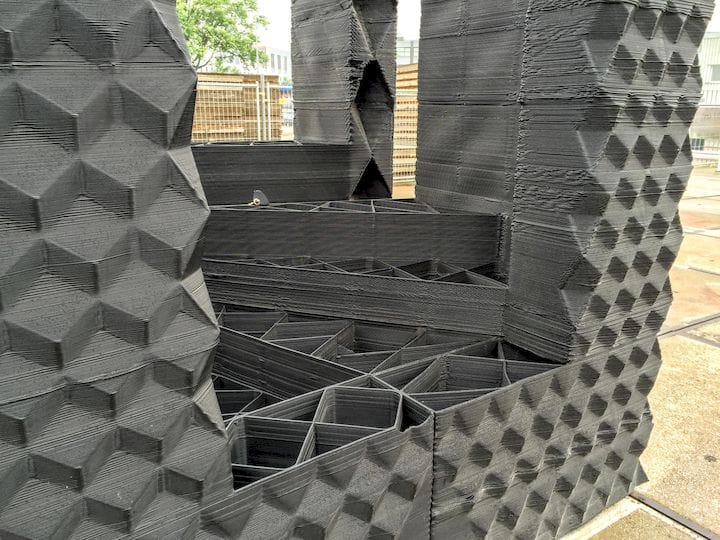![How do you know when to invest in a construction 3D printer venture? [Source: Fabbaloo]](https://fabbaloo.com/wp-content/uploads/2020/05/image-asset_img_5eb0a3011fa25.jpg)
Recently there has been a spate of investment in construction 3D printer manufacturers, but is this wise?
I’ve been quite skeptical of many construction 3D printer ventures for some time, perhaps due to the inevitable and highly misleading marketing programs undertaken by such companies, which often claim to have “3D printed a home in 24 hours!” or similar.
Some of the investors into these ventures have been burned as the proprietors haven’t really got a proper business, so it is imperative to look into the venture first.
Of course, nothing of the sort actually occurred. Virtually all of these construction 3D printer ventures are simply automating concrete extrusion. That’s obviously an important aspect of any building construction project, but is by no means the entirety of the activity.
Real projects require, in addition to the concrete work, other construction disciplines, such as HVAC, plumbing, electrical, windows, surface finishes, ceiling, lighting, painting and more. All of the “24 hour homes” required these to be done in the same manner they’ve been done elsewhere: slowly by professional tradeworkers doing it manually.
Construction 3D printers do not have any effect on that portion of the work. In fact, one “24 hour” venture even admitted that although the concrete printing was done in less than 24 hours, the remaining construction work required WEEKS to complete. In other words, the presence of 3D printed concrete had minimal, if any, effect on the duration to construct the building.
If buildings were truly “3D printed in 24 hours”, much more work would have to be done. We contemplated what that work might be in this post, if you’re interested.
In spite of this confusion, we still see companies investing in construction 3D printer companies, often without doing appropriate due diligence. I’m thinking we could provide some advice to them by means of a set of questions that could be posed to the company.
Let’s go through some investor questions, and potential answers:
Question: What is your venture’s goal?
Wrong answer: To enabled third world countries to 3D print complete homes in 24 hours using dirt.
Right answer: To optimize the presently manual process of pouring concrete, particularly for unusual geometries.
Question: How does your process work?
Wrong answer: We stuck a concrete extruder on the end of a robot arm and drive it around the site surface in a wobbly manner.
Right answer: We have a three-axis mechanism that enables precise movement of the extrusion toolhead through the entire job site.
Question: How do you set up the equipment for a construction job?
Wrong answer: We build the entire machine on-site from parts with highly paid technicians.
Right answer: The equipment is automatically ready to go after unloading from transport to the site.
Question: How do you set up the site for a construction job?
Wrong answer: We have to completely level the site with earth moving equipment and then spend several days pounding the surface to ensure it’s strong enough to hold up the concrete extrusion.
Right answer: The machine prepares the site itself.
Question: What is the total time comparison of your process to a traditional build process for an identical structure, including all work from end-to-end?
Wrong answer: 24 hours!
Right answer: Our process speeds up the concrete deposition process by approximately 50%.
Question: What is the total cost comparison of an identical structure build between your process and a traditional approach?
Wrong answer: We haven’t calculated that yet.
Right answer: About the same, but the concrete deposition is 25% less costly
Question: Does your machine actually exist? Can we see it in action?
Wrong answer: No.
Wrong answer: Here’s a picture of something we did.
Right answer: Yes, come to [NOTABLE ADDRESS] to see it running on Tuesday.
Question: How is your concrete process functionally any different than traditional approaches?
Wrong answer: IT’S 3D PRINTED!
Right answer: We use custom made design software to enable creation of building geometries that would be highly expensive to produce using conventional approaches. It’s the software, not the hardware, that matters most.
Question: How do you handle embedding windows, plumbing, electrical or other aspects that depend on the concrete structure?
Wrong answer: We manually insert those things into the wet concrete before it sets. Hopefully.
Right answer: Our specialized design software accounts for these items in its design and either inserts custom shapes into the print, or allows for pauses for tradesmen to do their specialty work.
Question: What material is used in your process?
Wrong answer: Dirt!
Right answer: Locally supplied concrete mixes with [CERTAIN SPECIFICATIONS].
Question: Where do you intend to spend the investment money?
Wrong answer: To keep us afloat for another two months!
Right answer: We want to market to large construction firms in hope they will adopt our unique process with their existing clients.
Maybe those aren’t the only questions one could ask, but if you did you might get a pretty clear idea of what the firm hopes to achieve and whether they can do so.











COBOD’s BOD2 construction 3D printer seems to be catching on as the company has made multiple sales of the new device.